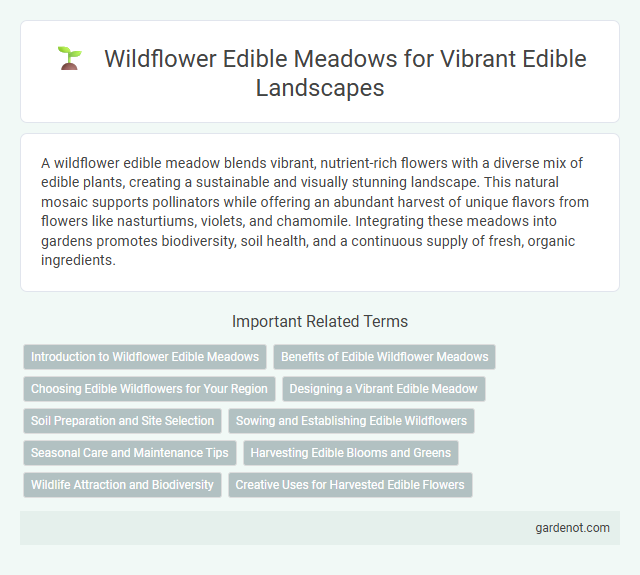A wildflower edible meadow blends vibrant, nutrient-rich flowers with a diverse mix of edible plants, creating a sustainable and visually stunning landscape. This natural mosaic supports pollinators while offering an abundant harvest of unique flavors from flowers like nasturtiums, violets, and chamomile. Integrating these meadows into gardens promotes biodiversity, soil health, and a continuous supply of fresh, organic ingredients.
Introduction to Wildflower Edible Meadows
Wildflower edible meadows combine diverse native flora to create vibrant, sustainable landscapes rich in nutrients and flavors. These meadows support pollinators, enhance soil health, and provide an abundance of edible plants such as clover, dandelion, and chickweed. Incorporating wildflower edible meadows into gardens promotes biodiversity while offering fresh, seasonal foraging opportunities.
Benefits of Edible Wildflower Meadows
Edible wildflower meadows enhance biodiversity by attracting pollinators such as bees and butterflies, which improve ecosystem health and crop yields. These meadows provide seasonal foraging opportunities with nutrient-rich flowers and leaves, offering both culinary and medicinal uses. Maintaining edible wildflower meadows supports soil health through natural nitrogen fixation and erosion control, promoting sustainable land management.
Choosing Edible Wildflowers for Your Region
Selecting edible wildflowers for your wildflower edible meadow depends on your region's climate, soil type, and native plant species to ensure optimal growth and sustainability. Popular choices include nasturtiums, violets, and calendula, each offering unique flavors and nutritional benefits that complement local ecosystems. Prioritize native or well-adapted species to promote biodiversity, reduce maintenance, and enhance the ecological balance of your edible landscape.
Designing a Vibrant Edible Meadow
Designing a vibrant wildflower edible meadow incorporates diverse native wildflower species that provide both aesthetic appeal and nutritional benefits, supporting pollinators and enhancing biodiversity. Selecting plants such as purple coneflowers, black-eyed Susans, and bee balm ensures a continuous bloom cycle while offering edible petals, leaves, and seeds. Integrating companion crops like herbs and salad greens optimizes space and encourages a resilient, sustainable edible landscape.
Soil Preparation and Site Selection
Selecting a well-drained site with ample sunlight is crucial for establishing a thriving wildflower edible meadow, as most edible wildflowers require at least six hours of direct sunlight daily. Soil preparation involves testing pH levels to ensure a range between 6.0 and 7.5, followed by amending the soil with organic matter such as compost to enhance fertility and texture. Removing existing vegetation and loosening the top 6-8 inches of soil promotes optimal seed-to-soil contact, improving germination rates and overall meadow health.
Sowing and Establishing Edible Wildflowers
Sowing edible wildflower meadows requires well-prepared soil, free from weeds and with good drainage to support seed germination and root development. Selecting a diverse mix of native wildflower species ensures year-round blooms and attracts pollinators while providing a variety of edible parts, such as petals, leaves, and seeds. Establishing the meadow involves gentle watering, avoiding soil compaction, and maintaining a balance between wildflowers and grasses to promote healthy growth and sustainability.
Seasonal Care and Maintenance Tips
Wildflower edible meadows require seasonal care such as regular watering during dry spells and periodic mowing to encourage healthy growth and prevent invasive species from taking over. Applying organic mulch helps retain soil moisture and suppress weeds while enriching soil nutrients for diverse edible plants. Monitoring for pests and diseases early in spring and employing natural pest control maintains a thriving, productive meadow throughout the growing season.
Harvesting Edible Blooms and Greens
Harvesting edible blooms and greens from a wildflower edible meadow requires careful identification of safe, non-toxic species such as calendula, violets, and dandelion greens. Optimal harvesting occurs during the early morning when petals and leaves are fresh, maximizing flavor and nutritional content. Regular, gentle picking promotes continuous growth and a sustainable, productive meadow environment.
Wildlife Attraction and Biodiversity
Wildflower edible meadows create vibrant habitats that attract a wide range of pollinators, birds, and beneficial insects, enhancing local biodiversity. By integrating native edible plants, these meadows support complex ecosystems, contributing to soil health and ecological balance. Their diverse floral composition encourages natural pest control and promotes resilient wildlife populations throughout the seasons.
Creative Uses for Harvested Edible Flowers
Harvested edible flowers from a wildflower edible meadow offer versatile culinary and decorative applications, enhancing dishes with vibrant colors and unique flavors such as subtle sweetness or mild peppery notes. Chefs and home gardeners incorporate these blossoms into salads, teas, syrups, and desserts to elevate visual appeal and nutritional value, leveraging petals from species like calendula, nasturtium, and borage. Preserving edible flowers through drying or infusing in oils and vinegars extends their shelf life, enabling creative use beyond seasonal availability.
Wildflower edible meadow Infographic

 gardenot.com
gardenot.com